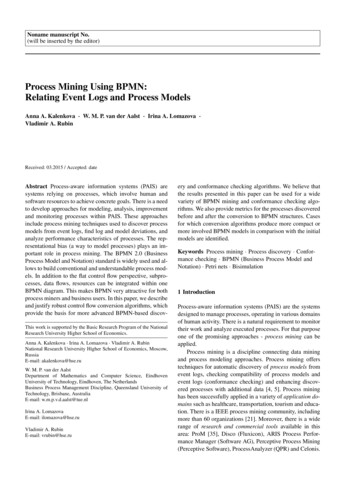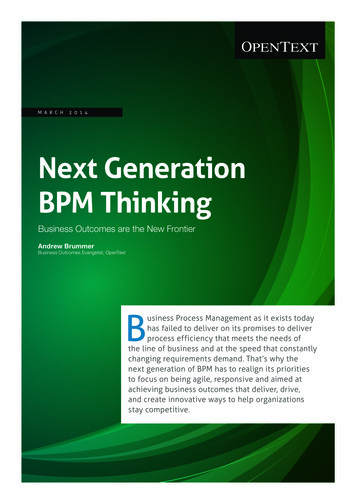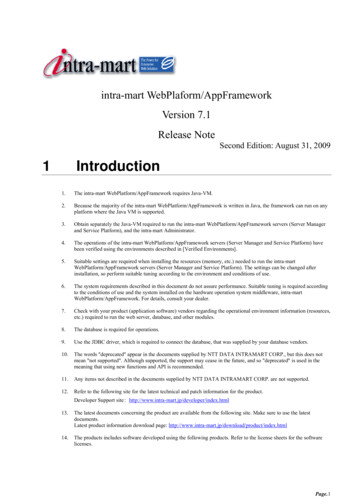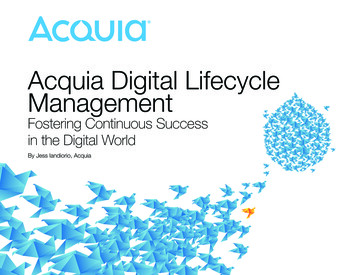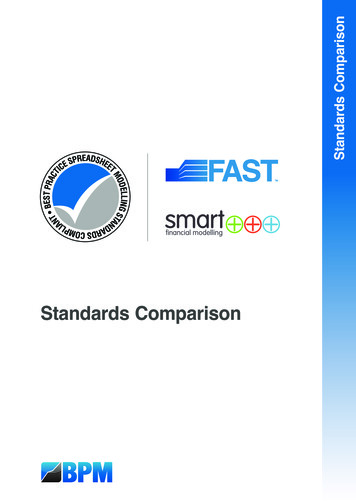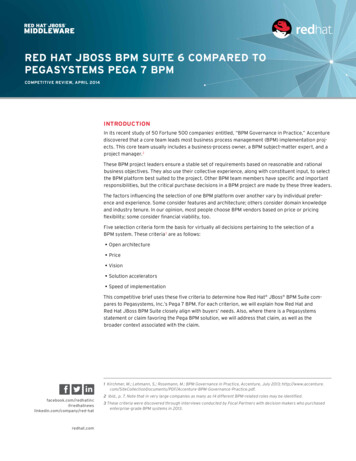
Transcription
Communication Papers of the Federated Conference onDOI: 10.15439/2018F46Computer Science and Information Systems pp. 205–211ISSN 2300-5963 ACSIS, Vol. 17Evolution of the BPM LifecycleMarek SzelągowskiVistula Universityul. Stokłosy 3,02-787 Warszawa, PolandEmail: marek.szelagowski@dbpm.plAbstract—The process lifecycle systematizes the method ofimplementing and managing business processes in theorganization. Due to changes in the social culture and theavailability of technologies, the process lifecycle are alsoundergoing constant changes. The aim of this article is toanalyze the direction of these changes and to propose a newprocess lifecycle, which would account for the requirements ofthe knowledge economy.The article presents an overview of relevant literature onmanaging the process lifecycle. In the second part, it discusseschanges to the principles of holding business operations, whichare increasingly more limiting with respect to the scope ofusing traditional process management. In the third part, thearticle proposes an updated the business process lifecycle,which would adjust the lifecycle to observed business changesand make use of emerging ICT solutions. The proposed processlifecycle guarantees the coherence of the implementationprocess in KE.The article presents an overview of relevant literature onmanaging the process lifecycle and on this basis putsforward a proposal of a more general approach to theprocess lifecycle in the organization; one taken from aprocess-centric perspective. In the second part, it discusseschanges to the principles of holding business operations,which are increasingly more limiting with respect to thescope of using traditional process management andemerging ICT solutions. In the third part, the articleproposes an updated model of the process lifecycle, whichwould adjust the lifecycle to observed business changes andmake use of emerging ICT solutions, which offer real-timesupport to dynamic business process management.III. THE BPM LIFECYCLE IN TRADITIONAL PROCESSMANAGEMENTI. INTRODUCTIONTHE process lifecycle is a schematic overview of themethod of implementing and managing processes in theorganization. It has the role of a “map” of the fundamentalbusiness-process-managing process in the organization. Itsrole is to present the main idea, or the cardinal principles, ofprocess management, in a manner which enables theircoherent and intuitive understanding by those participatingin the implementation at present or in the future. For thisreason, the process lifecycle cannot be over-complicated,albeit it should nonetheless be detailed enough andpracticable enough as to make possible the shift towardmore detailed models, which capture in detail the workflowof specific stages of the process lifecycle in the organization.Due to changes in the social culture and the availability oftechnologies, or, more generally speaking, changes toholding business operations, process management ingeneral, and the process lifecycle in particular, are alsoundergoing constant changes. The aim of this article is toanalyze the direction of these changes and to propose a newprocess lifecycle, which would account for the requirementsof the knowledge economy and the development of ICTsolutions, such as process mining, robotic processautomation (RPA), machine learning (ML), and artificialintelligence (AI).c 2018, PTIII. METHODOLOGY205Literature presents numerous models of process lifecyclesin the organization, which emerged within the framework ofthe traditional concept of business process management andwere authored by: consulting and implementation companies, e.g.Gartner [1] software vendors, e.g. Software AG [2] academic researchers [3].A. The process lifecycleThe concepts present illustrative approaches to theprocess lifecycle in the organization as a sequence ofcyclical stages [4]. As a point of departure for this analysisthe article selected the DMEMO cycle (an acronym coinedfrom the first letters of the names of the subsequent stages:Design, Model, Execute, Monitor, and Optimize) [5], whichis analogous to the DMAIC (Define, Measure, Analyze,Improve, and Control) cycle known from SixSigma [6].Other process lifecycle models prepared within theframework of traditional business process management arealso divided into stages presenting subsequent steps of theprocess lifecycle in the organization. Examples include: Define, model, simulate, implement, execute,monitor, analyze, optimize (Gartner) [1] Strategize, design, implement, compose, execute,monitor & control [2]
206COMMUNICATION PAPERS. POZNAŃ, 2018Fig. 1 The DMEMO process lifecycleSource: [5]Model, simulate, implement, deploy & execute,monitor, optimize [7] Model, implement, execute, monitor, optimize [8] Discovery & remodeling, validation & simulation,deployment & execution, monitoring & performancemanagement, improvement [9] (Re)design, configuration, enactment, diagnosis [10] Identification, modeling, implementation, controlling,process improvement [11] Analysis, design and modeling, implementation,monitoring and controlling, redefining and planning[12]To generalize, within the framework of traditional processmanagement the process lifecycle may be described as acycle comprising sequentially executed stages with the aimof: Designing processesThis stage has the goal of preparing descriptions ofprocesses existing in the organization (as is) and analyzingthem on the basis of the organization's data, and, first andforemost, the knowledge of its personnel. In result of suchanalysis, an improved (to be) process model is prepared.In traditional models that are commonly found inliterature, this stage often contains or is defined as:identification, discovery, defining, redefining, designing,modeling, formalizing, simulation research, processoptimization, etc. Implementing processesThis stage has the goal of accommodating theorganization's operations to the designed process model.This accommodation encompasses both training andchanges to the work of the personnel, as well as changes tothe operations of the ICT infrastructure and the IT systems,including process performance automation.In traditional models that are commonly found inliterature, this stage often contains or is defined utomation, etc. Process performance and monitoringThis stage has the goal of performing and monitoringbusiness operations in accordance with prepared andimplemented process descriptions. It is becomingincreasingly more common in this stage to use techniquesand analytical tools from the fields of BigData, internet ofthings (IoT), process mining, robotic process automation(RPA), machine learning (ML), artificial intelligence (AI),and expert systems.In traditional models that are commonly found inliterature, this stage often contains or is defined as:performance, monitoring control, measurement, etc. Process analysis and improvementThis stage has the goal of evaluating process performanceand improving process descriptions with the aim of raisingefficiency, minimizing risks, etc. At this point, techniquesand analytical tools are used from the fields of BigData,process mining, artificial intelligence, and expert systems.In traditional models that are commonly found inliterature, this stage often contains or is defined as: analysis,diagnosis, optimization, improvement, etc.B. The life cycle of processes in the organization (BPMLifecycle)Due to the identified necessity of approaching the processlifecycle from the perspective of implementing andperforming multiple processes in the organization, the articleproposes a process lifecycle model, which apart from thelifecycle of a single process also encompasses actions whichfrom the perspective of the organization prepare theimplementation of process management. This "global" lifecycle of processes in the organization we will call BusinessProcess Management Lifecycle in organization (in short:BPM Lifecycle). To this end, some consulting companiesand researchers supplement the process lifecycle with aninitial stage named: The formulation of vision [5] Process identification [3] Initial Process Planning and Strategy [4]the aim of which is to define the goals and methods ofprocess management in accordance with the strategy of theorganization and its level of process maturity, prepare acorresponding plan of an implementation project for processmanagement, as well as hold training courses for theorganization's management and personnel.This stage results in the preparation of a processarchitecture, which includes, among others, the agreed-upongoals and performance indicators, as well as priorities in thesequence of implementing particular groups of processes.In traditional models that are commonly found inliterature, this stage often contains or is defined as: planning,preparation, strategizing, identification, etc.This elaboration, however, does not change the essence ofdepicting the process lifecycle (or BPM Lifecycle) withinthe framework of traditional process management as asequence of stages performed one after another, preceded bya one-off execution of preparatory stages, which initiate the
MAREK SZELĄGOWSKI: EVOLUTION OF THE BPM LIFECYCLEFig. 2 The BPM lifecycle.Source: [3]implementation of process management in the organization.For all practical purposes, it is an extension of E. Deming'sPDSA cycle, which has been designed over 50 years ago,usually supplemented with additional “modern” ICTelements, such as: simulation, exploration, implementation,automation, reporting, etc.IV. THE LIMITATIONS OF TRADITIONAL PROCESSMANAGEMENTIf we take a diagram depicting the BPM Lifecycle andreplace symbols corresponding to subsequent stages (usuallycircles or ellipses) with symbols for subprocesses knownfrom the Business Process Model and Notation (BPMN), theBPM Lifecycle (e.g. the model created by Dumas, La Rosa,Mendling, and Reijers from Fig. 2) will depict a normal,sequential “relay” process with a single feedback loop, thegoal of which is to ensure periodical analysis and improvethe process model on the basis of data derived in the courseof its performance.207which will be initiated after their acceptance (for newprocess instances). For processes which have alreadyinitiated performance (existing process instances) suchchanges are not visible. They are performed in accordancewith an outdated version of the process description, evenwhen it is apparent that it contains errors and may result inlosses, and when we already know how the process may beimproved upon. This nonsensical principle is furtherimplemented in process-centric applications supportingprocess performance: the process performers use anapplication which was up to date in the moment of processinitiation, even when an updated application is readilyavailable.This is fully in accordance with the principles of thetraditional concept of process management, in which processperformers are prevented from introducing changes in thecourse of performance itself. The course of the process isdefined in the form of a description, or rather, an“algorithm,” prepared prior to initiating performance itself.In consequence, traditional process management lacks thepossibility of quickly using knowledge obtained by theperformers in the course of performance. In effect, thisconcept also does not offer the possibility of the operationaluse of new technologies, such as process mining, machinelearning, or artificial intelligence, in the course ofperformance. Such use would require the authorization tochange the process in the course of performance as the resultof analyzing information obtained in the course thereof. Thislimitation results in the traditional BPM Lifecycle beinginadequate in the case of about 70% of the processesperformed in the knowledge economy [13][14]. Thisparticularly pertains to essential processes, in whichknowledge is constantly being created and verified, such ase.g. diagnostic-therapeutic processes, research anddevelopment processes, and personalized services.Fig. 3 The BPM Lifecycle as a process diagram in the BPMN notation.Source: Author's own elaboration, on the basis of [3]Fig. 4 The process lifecycle in the process mining methodology.Source: [15]In effect, processes cannot be improved upon or evenchanged at all during performance itself – this is possibleupon completion and analysis alone. Most processsupporting workflow systems, document managementsystems, and Business Process Management Systems(BPMS) worked exactly in accordance with this principle.Even upon introducing changes to the course of a process,such changes will only be visible for process performancesThe management of such processes requires the processperformers (or artificial intelligence) to be empowered toshape the processes on their own behalf, which requiresintroducing changes to the process lifecycle (and BPMLifecycle), which are qualitatively deeper than just addingor subtracting subsequent stages of a sequential, routinecycle.
208COMMUNICATION PAPERS. POZNAŃ, 2018Among the process lifecycle models within theframework of traditional process management, a trulysignificant qualitative change was proposed in 2012 by theauthors of the Process Mining Manifesto belonging to theIEEE Task Force on Process Mining (Fig. 4) [15].The process execution stage has been supplemented withan additional “Adjustment” loop, the aim of which is toadapt the process in the course of performance itself. Thestandard process lifecycle has also been supplemented witha (re)configuration stage, in which changes are made ment, document management, RPA, or BPMS)without having to repeat the implementation stageperformed e.g. as the result of creating separate processperformance scenarios. When recommending the change ofthe process lifecycle, the authors of the Process MiningManifesto have stressed that organizations should alsoinclude the possibility of adjusting processes in the stage ofdesigning processes and their supporting IT tools("Analysis" loop). It has been clearly underlined that in the(re)design stage, analysis is held in the form of e.g.simulation research on the proposed process model or in theform of comparative analyses of the new process patternwith data on completed performances (researchingcompliance or extending the model as the result of processmining search) [13], with the end result being redesignedand reconfigured systems supporting process performance,e.g. RPA / using elements of AI or its integrating workflowsystems / document management / BPMS.This is a clear step toward changes to the processlifecycle, which allows for the dynamic management ofprocesses. Having the option to improve processes in thecourse of their performance in the form of fixes, updates,adaptations, or limited experiments provides the processperformers with the power to verify and create newknowledge in the course of their work with the use ofmachine learning or artificial intelligence. At the same time,the analysis of process performance in the (re)design stageallows for the uncovering of such knowledge thanks toprocess mining or analyzing the course of machine learning.V. THE BPM LIFECYCLE IN DYNAMIC BPMFor full compliance with the concept of dynamic businessprocess management, it is essential to manage the uncoveredknowledge through the systemic combination of revealingknowledge with its evaluation and distribution. This,however, requires us to take the concept of processlifecycles in a direction in which the performance of aprocess will not be equal with the perfect repetition of thestandard, but rather, the repetition or adaption of thestandard with the best possible results in mind, in a mannerwhich is the most adequate in a given context and within thelimits of the executive privileges of the performer. Suchadaptations may be introduced by: process performersprocess performers with the use of ICT solutions (e.g.online machine learning) elements of autonomic artificial intelligenceThe postulated changes have been introduced in theprocess lifecycle model designed by the author inaccordance with the concept of dynamic BPM. The model ispresented on Figure 5.The subsequent stages of the BPM Lifecycle of dynamicallymanaged business processes are as follows:Defining goalsIn this stage, the goals of the project of implementingbusiness process management, the goals of themegaprocesses, and the goals of knowledge management inthe organization, as well as the principles of implementationthemselves, are defined and agreed upon with thestakeholders. Fig. 5 The BPM Lifecycle in accordance with dynamic process management.Source: author's own elaboration.This stage results in the formulation of a definition ofgoals and a process map (and the de facto decision to initiatethe implementation of business process management).Preparation of the projectThe goal of this stage is to prepare the organization forthe implementation of process management by: defining or verifying the organization's level ofprocess maturity[16] developing a method of process description andcommunication which is the most suited to thecharacter of the performed processes holding training sessions for the management and thepersonnel of the organization.The performance of this stage results in the creation of aprocess architecture and an implementation plan, which takeinto account the level of process and technological maturityand the culture of the organization.(1) The (re)Design stageIn this stage, process descriptions and their correspondingdata are created. Process discovery is performed with the useof:
MAREK SZELĄGOWSKI: EVOLUTION OF THE BPM LIFECYCLEstandard models for the field in which theorganization operates, the knowledge of the employees, exploratory research (“discovery” / “mining”), analyses of data and the results of machine learning.Depending on the level of dynamism of the processesinvolved, process descriptions may take the form of: for static processes – detailed descriptions, usuallyprocess models comprising interconnected processdiagrams, for dynamic processes – detailed process descriptionsIn the form of models comprising process diagramsand/or collections of tasks to be accomplished duringprocess performance (e.g. in the form of anontology), as well as the data required during thedecision-making process and in the documentationstage.This stage should also encompass the preparation ofrequirements for RPA, as well as the preparation ofprototypes of process-driven applications, which in the leastshould include the information content of the user interface,the possible range of standard reports, and the scope ofintegration with ICT infrastructure or BigData repositories.Furthermore, in this stage, the organization's internal rulesand regulations should be – where required – updated forconsistency between process management and other fieldsof management.Communication and cooperationIn the (re)Design stage – in accordance with the principlesof dynamic business process management – in order to makegood use of the broadest possible part of the organization'sintellectual capital, proposed process descriptions,prototypes, or applications and robotic process automation,which have been cleared for testing, should be consultedwith in-house and external experts, and, first and foremost,with practitioners themselves, who use them on a dailybasis, through e.g. communities of practice or social mediawebsites. (2) The Implementation and adjustment stageIn this stage, process descriptions are implemented (andeventual changes to other internal regulations areintroduced) along with their supporting RPA and processcentric applications within the organization. In this stage, itis possible to adapt process descriptions and theconfigurations of their supporting robotic processautomation and systems to the needs and requirementsidentified during implementation. Should it turn out that adesigned process or configuration of a process-centricapplication does not meet the expectations of the users, it ispossible to return to the (re)Design stage in order to preparethe process descriptions and applications once again.(3) The Execution and monitoring stageIn this stage, business processes are performed and dataon their performance is collected on an ongoing basis. For209transaction systems (e.g. MRPII, CRM, ERM, HIS, etc) andprocess-based systems (workflow / document management /BPMS), as well as RPA and AI, they are stored in eventlogs. Data from other sources (e.g. mobile applications,social media applications, e-mail accounts) should beintegrated within a unified data source (BigData). Suchinformation should be monitored by control systems on anongoing basis, as well as analyzed and used in the ongoingsupport of knowledge workers by robotic processautomation and/or elements of artificial intelligence.Attempts to improveIn accordance with the 2nd principle of dynamic businessprocess management [17], knowledge workers (and in thefuture – autonomic artificial intelligence as well) have thepower to create or adapt described business processes to therequirements of a specific context of performance and thechanging general conditions of process performance (e.g.changing technologies, principles of competition, or theindividual, unpredictable context of performance). Suchactive experiments have the goal of arriving at new solutionsenabling the performance, or the optimization of theperformance, of a process.(4) The Analysis and diagnosis stageIn addition to business processes being monitored in theExecution and monitoring stage, business processes arenevertheless evaluated ex-post by means of: standard control actions, including the control ofprocess efficiency, duration, costs, resources used,risks involved, etc.; discovering the actual course of the performedprocesses and evaluating the results of theimplemented improvements with the aim of:o broadening the processes of the organizationthrough communication (adding to the list of bestpractices and informing about the update), as wellas redesigning and tailoring processes and theirsupporting applications and robots;o communicating information on the negativeresults of specific attempt at improving a process(adding to the list of wrong practices andinforming about the update);o initiating a broader evaluation of the possibilitiesof using a discovered potential improvement(while informing the stakeholders about thepossibility of participating in the discussion).Knowledge obtained in this stage should besystematically communicated to authorized members of theorganization, with a particular focus on the employees whoare directly responsible for process performance, for whomnew or verified knowledge might have direct significance(in the Execution and monitoring stage). This requires theexistence within the organization of a culture andmechanisms of internal communication, which allow for theongoing, broad improvement of processes and thedistribution of knowledge, as well as the existence of an ICT
210COMMUNICATION PAPERS. POZNAŃ, 2018infrastructure enabling the rapid introduction of changes andtheir communication.At the same time, within the proposed lifecycle model fordynamically managed processes improvements resultingform practical attempts at innovation, which have beengiven a positive evaluation, may be introduced in theExecution and monitoring stage directly following the(re)Design stage, without the necessity of going through theImplementation and adjustment stage. As previously, thisrequires organizations to develop efficient mechanisms ofinternal communication both on the level of social culture,as well as on the level of ICT infrastructure, understood ase.g. the broad acceptance and the efficient use of mobiledevices, social media applications, or elements of artificialintelligence.work in real time: process mining, machine learning,and artificial intelligence.Taken together, both these factors result in the scope ofprocesses requiring dynamic management becoming larger,and, at the same time, allow access to a growing number oftools supporting knowledge workers in this regard.Nevertheless, they exert growing pressure on theorganization on the part of the competition and the clients.The BPM Lifecycle proposed in this article requires theadjustment of methodologies and tools supporting processmanagement with a view to the efficient use of bothemerging ICT technologies and the intellectual capital of theorganization, encompassing the entire process lifecycle.VII. REFERENCES[1]VI. CONCLUSIONIn the knowledge economy, a mere 30 percent ofprocesses within the organization are static in nature, forwhich detailed models or even algorithms may be preparedprior to performance[18][19][20]. The remaining 70 percentof processes are processes which require dynamicmanagement, or the empowerment of their performers tointroduce changes in the course of performance itself. Ashas been shown in the article, the development of processmanagement requires the introduction of a qualitativechange to the process lifecycle, which would account for thepossibility, and in the case of a large majority of dynamicprocesses – the necessity, of using the knowledge of theprocess performers to tailor the processes to the context of aspecific performance. Without this change it is impossible tomake efficient use of new technologies, such as processmining, machine learning, or artificial intelligence. Withinthe framework of traditional process management, the use ofsuch technologies in the course of a process lifecycle isimpossible or ineffective, as it provides benefits only uponsubsequent performance of the process in question (or uponan even more delayed approval of the change by a group ions of process management in accordance withthe traditional BPM Lifecycle were seen and remain to beseen as a success only because: they pertain to static (repeatable, routine,unchangeable) processes, the optimization orautomation of which (e.g. through RPA) allows us toraise the pace of performance and lower costs andrisks sub-optimal performance or losses duringperformance are so high that in effect anyimprovement initiatives bring about tangible effectsHowever, the situation is changing due to: the number of static processes in the organizationsteadily becoming lower the possibility of using new ICT technologies, amongwhich one should primarily mention those 15][16][17]G. Polancic, “Learning BPMN 2.0 – Business Process Vs n/business-process-vsworkflow/Software AG, “Enterprise BPM series: a summary,” 011-07-26-enterprisebpm-series-summaryM. Dumas, M. La Rosa, J. Mendling, and H. Reijers, Fundamentals ofBusiness Process Management. Heidelberg: Springer, 2016.R. Macedo de Morais, S. Kazan, S. Dallavalle de Padua, and A. Costa,“An analysis of BPM lifecycles: from a literature review to aframework proposal,” Business Process Management Journal, Maypp. 412-432, 2014, doi: 10.1108/BPMJ-03-2013-0035.BPM Resource Center, “Understanding BPM and RelatedImprovement Methodologies,” 2014, http://www.what-is-bpm.com/get started/bpm methodology.htmlP. Pande, R. Neuman, and R. Cavanagh, “Six Sigma”, Warszawa,K.E. Liber S.C., 2003, pp. 37, 141-142.T. Gulledge, S. Hiroshige, and D. Manning, “Composite Supply ChainApplications,” 2011, cations, p. 49, doi: 10.5772/21927.PNM SOFT, “BPM Lifecycle,” 2017, lifecycle/A. Pourshahid, D. Amyot, L. Peyton, S. Ghanavati, P, Chen, M. Weissand A. Forster, “Business process management with the userrequirements notation,” Electronic Commerce Research, vol. 9, 2009,pp. 269–316, doi: 10.1007/s10660-009-9039-zC. Di Ciccio, A. Marrella, and A. Russo, “Knowledge-intensiveProcesses Characteristics, Requirements and Analysis ofContemporary Approaches,” Journal on Data Semantics, vol. 4, no. 1,pp. 29–57, https://www.researchgate.net/profile/Claudio Di Ciccio/publication/269629902 KnowledgeIntensive Processes Characteristics Requirements and Analysis ofContemporary Approaches/links/576a501a08ae1a43d23bca3c.pdfA. Bitkowska, „Zarządzanie procesowe we współczesnych organizacjach,” 2013, Warszawa: Difin SA, pp. 66-83.R. Bernardo, G. Ribeiro, and S. Dallavalle de Pádua, “The BPMlifecycle How to incorporate a view external to the organizationthrough dynamic capability,” Business Process Management Journal,vol. 23, no. 1, 2017, pp. 155 – 175.E. Olding and C. Rozwell, “Expand Your BPM Horizons byExploring Unstructured Processes.”, 2009, Gartner Technical ReportG00172387,.K. Swenson, “Mastering the Unpredictable: How Adaptive Case Management Will Revolutionize the Way That Knowledge Workers GetThings Done.” Tampa (USA): Meghan-Kiffer Press. 2010. pp. 30-31.Process Mining Manifesto. 2012, http://www.win.tue.nl/ieeetfpm/doku.php?id shared:process mining manifestoK. Kania, „Doskonalenie zarządzania procesami biznesowymi w organizacji z wykorzystaniem modeli dojrzałości i technologii informacyjno-komunikacyjnych,” Katowice: Wydawnictwo UniwersytetuEkonomicznego w Katowicach, 2013, pp. 85-87.M. Szelągowski, “Becoming a Learning Organization Through Dynamic Business Process Management,” Journal of Entrepreneurship,
MAREK SZELĄGOWSKI: EVOLUTION OF THE BPM LIFECYCLEManagement and Innovation (JEMI), vol. 10, no. 1, 2014, pp. 147166.[18] HandySoft, “Dynamic BPM – The Value of Embedding Process intoDynamic Work Activities: A Comparison Between BPM and Paper 0.pdf.211[19] T. Austin, “Gartner Says the World of Work Will Witness 10
implementation of process management. This "global" life cycle of processes in the organization we will call Business Process Management Lifecycle in organization (in short: BPM Lifecycle). To this end, some consulting companies and researchers supplement the process lifecycle with an initial stage named: The formulation of vision [5]


